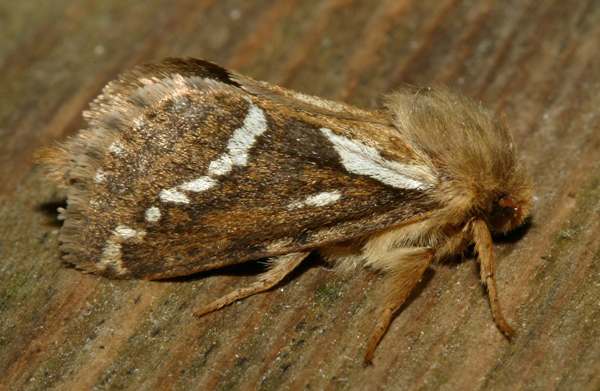Common Swift - Hepialus lupulinus
Phylum: Arthropoda - Class: Insecta - Order: Lepidoptera - Family: Hepialidae

Five of the approximately 500 species of the Hepialidae moths (Swift moths) occur in Great Britain and Ireland.
The forewings of the Common Swift Moth are very variable in colour and markings making this, the most common of the species of Swift Moths to occur in Britain and Ireland, rather difficult to identify.They fly mainly at dusk, and can easily be caught in light traps.
They are not at all particular in their choice of habitat occuring in both urban and rural locations from gardens, roadside verges to fens and woodlands.
The forewing of the Common Swift ranges between 11 and 16mm (Male) and 15 and 20mm (Female)
Distribution
In Britain and Ireland this resident moth is found throughout although more common in the south and east than in the north. It is more localised in Scotland and Ireland.
Lifecycle
The Common Swift moth is shortlived as its shortened proboscis prevents it from being able to feed. It over-winters once in its larval form and pupates below ground.
The larval foodplants of the Common Swift include the roots many grass species as well other cultivated and agricultural plants. It can do serious damage to both garden plants and agricultural crops.
Picture: Rob Petley-Jones
Studying butterflies and moths...
Excited at the prospect of flyfishing? So are we, and we're pretty sure you would find the Winding River Mystery trilogy of action-packed thrillers gripping reading too. Dead Drift, Dead Cert, and Dead End are Pat O'Reilly's latest river-and-flyfishing based novels, and now they are available in ebook format. Full details on our website here...
Buy each book for just £4.96 on Amazon...
Please Help Us: If you have found this information interesting and useful, please consider helping to keep First Nature online by making a small donation towards the web hosting and internet costs.
Any donations over and above the essential running costs will help support the conservation work of Plantlife, the Rivers Trust and charitable botanic gardens - as do author royalties and publisher proceeds from books by Pat and Sue.
